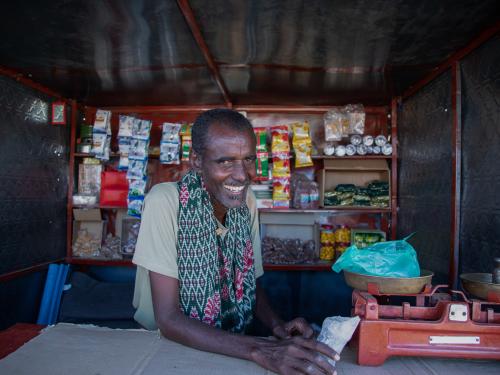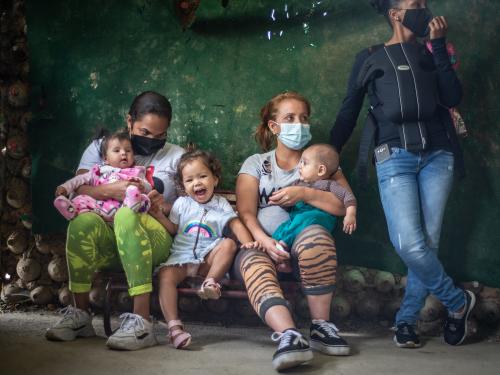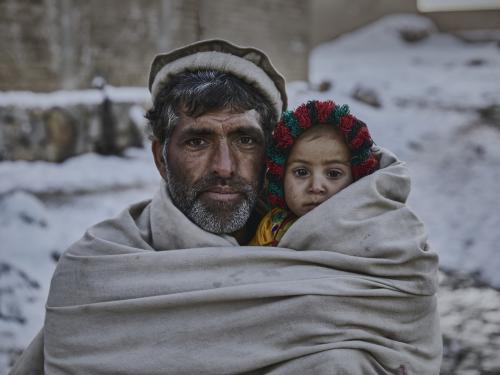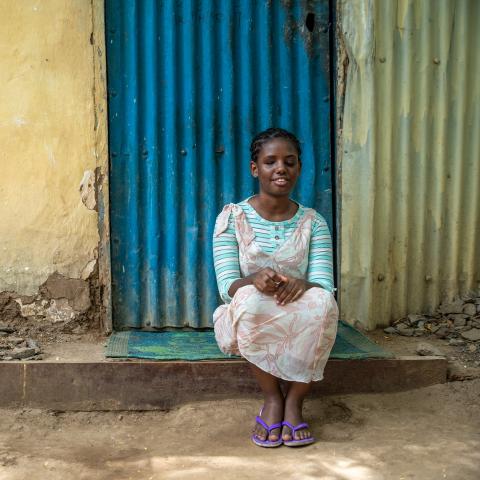Report
The Global Report presents the work carried out by UNHCR in 2021 to protect and improve the lives of tens of millions of people of concern—refugees, returnees, internally displaced people, stateless persons, and others of concern. It highlights the year’s achievements, as well as challenges faced by the organization and its partners, in attempting to respond to multiple life-threatening crises and ever-growing humanitarian needs.
Tiliphonsa’s story
Monday 6:00 am. 2010.
I was getting ready for school.
Wait a minute! What is that sound? I hope it is not a gunshot. “Tiliphonsa!”Mom called, indicating with her hand that I should get down.
Immediately I lay down on my stomach and started crawling like a snake. This had been going on for a while now. It was now our daily life. The rebels were vigorously shooting at anyone and anything.It was not safe anymore to stay there.
In 2021, the number of people displaced like Tiliphonsa reached the highest level ever. People forced to flee their homes may seek asylum in foreign countries and become refugees, or they may be internally displaced – uprooted within their own country. This can happen to anyone. And when it does, they rely on UNHCR for help.
People of concern to UNHCR also include stateless people, and those who have recently returned after being forced to flee. All are vulnerable and are at risk of having their rights denied to them.
In 2021, UNHCR responded to 40 new emergencies around the world.
“ Our task is growing and becoming more complex. But we are determined to deliver, bolstered by a burgeoning global network of partners, and heartened by the great reserves of altruism, solidarity and generosity that persist in – and perhaps because of – our troubled world.
-- High Commissioner Filippo Grandi
Immediately Mom went into her room, crawling. She came out carrying my six-month-old younger brother on her back. In her arms, she pulled my school bag stuffed with a few clothes. She grabbed my right arm and whispered:
“We need to get out of here.” I hesitated but still followed her. It was a nightmare, I told myself.
“What about dad?” I asked, reluctant to go with her.
“Tiliphonsa!” she shouted.
“Not today, your dad will meet us. We have to stay alive.”We were leaving my home, the only place I ever loved.
UNHCR works in seven regions, each of which has sizable populations of concern.
You can read more about UNHCR’s work in each region here:
After seven weeks of walking and sleeping in bushes, we arrived in the refugee camp. A team of UNHCR staff received us. The camp was very crowded and noisy.
The camp was meant to hold up to 10,000 refugees but now houses nearly 40,000. We received a tent, two blankets, two pots, two plates and three spoons. It looked temporary. I hoped that we would return home to rebuild in a few months.
We managed to set up a tent. We had no idea that this place would now be our home for years to come.
When people are forced to flee, they are at great risk. UNHCR aims to ensure they can reach a place of safety and exercise their legal right to ask for asylum. Their mental and physical health may be at risk, including from gender-based violence. They may be separated from their families, or vulnerable due to their age, disability, gender or sexual orientation. They will need food, shelter, fuel, water, washing facilities, and basic items to cook with, as well as cash for urgent needs. UNHCR seeks to protect them and their rights. In 2021, UNHCR’s life-saving assistance included…
Every year UNHCR registers more and more people who have been forced to flee from their homes, a first step in ensuring their voice can be heard and their needs can be met. By the end of 2021, its PRIMES database had registered 21.7 million individuals, almost half of them with biometric records.
Four months later, we saw my father wandering into the camp. We were all happy because now our family was complete. He looked pale and thin. He had just escaped from rebels. They had held him captive those past months.
The horrors of his experience in captivity still haunted him, but he tried to act strong for us.
Who would believe that the man we saw was once the highly respected doctor back home?
He had lost his pride as a man. He could no longer provide for his family, and he depended on handouts from humanitarians to sustain all of us. We suffered to survive in the camp. The food ration dwindled daily due to the rapid increase in population.
UNHCR’s support is vital for people whose lives have been overturned, like Tiliphonsa’s father. However, UNHCR’s budget is underfunded, meaning that there is not enough money to meet the modest needs of people who have been forced to flee or who are stateless. Food, shelter, health care, sanitary facilities and education are all in short supply. In 2021, UNHCR budgeted for global needs of $9.248 billion, but it received only $4.680 billion, a 44% gap.
UNHCR is striving to raise more funds to ensure it can meet the needs of people like Tiliphonsa’s family, and to empower them to rebuild their lives. They rely on the generosity of UNHCR’s donors, as well as on the hospitality of the local community and the State where they have found safety. Many donors give generously to particular causes, while others let UNHCR channel their funds to the most neglected and urgent needs. Much of this kind of flexible support comes from private individuals and companies, who gave a record amount in 2021.
Overall, UNHCR’s biggest donors are governments and intergovernmental donors such as the European Union. In 2021, the top donors were as follows, with varying levels of flexibility in their funding:
After six months in the refugee camp, I got enrolled in school. My dad was unable to get a job. He had no documentation
to prove his eligibility, and he could not understand the official language in this host country. My mom had found work in the camp as a seamstress, making clothes.
Merely meeting people’s urgent and life-saving needs is not enough. Displaced and stateless people have ambitions and great potential to enrich society. UNHCR is asking governments to include them in education, employment and national health and social protection networks. But the countries that host big displaced populations often need help to do so, which is why UNHCR is championing a global movement to share the burden and the responsibility, involving not just governments, but companies, civil society, academia and NGOs, who came together in the Global Compact on Refugees in 2018 and at the subsequent Global Refugee Forum.
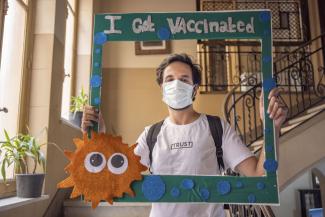
You can read more about this, and other global initiatives such as UNHCR’s COVID-19 response and its support for internally displaced people, here.
Here I am now. I have completed my studies, but I still can’t get a job because policies in this country are against refugee employment. The depression and hopelessness continue. There are millions of people like me all over the world. The numbers are increasing daily because people like me are running to safety from violence.
Our status is not by choice but by circumstances beyond our control. We just happened to find ourselves in this situation. Anyone can.
With all this suffering, we always hope for a happy ending.
A fundamental goal is to establish a life of stability and end people’s forcible displacement for good – either back in the place where they fled from, when it is safe to return, or in the place where they fled to, or in a new country.
In 2021, the numbers of refugees who returned home grew, as the COVID-related travel restrictions subsided, and some cooling of conflicts made it safe to go back.
The numbers accepted for resettlement in a new country also rebounded from 2020, but remained historically low, and far below the level required to meet the needs assessed by UNHCR.
Others were integrated into local communities, or found opportunities to study, work or reunite with their family in another country. But such opportunities remain far too scarce.
For stateless people too, there has been far too little progress, and UNHCR is urging governments to take action to eradicate statelessness globally. The number of people acquiring a nationality rose in 2021, but remained far below the level required:
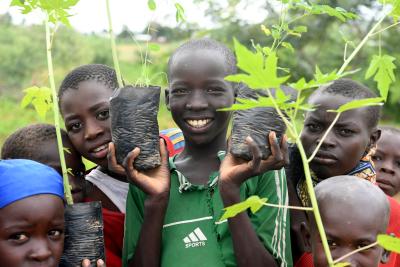
You can read more about UNHCR’s work to build better futures here.
Meet a real Tiliphonsa: Radwan
Tiliphonsa’s story illustrates how an ordinary girl can become a refugee and find her life is overturned by events. It is fictional, but representative of many true experiences. For a personal snapshot of the real experience, UNHCR asked Radwan, a young man whose family have been displaced in Sudan, to write about his life, and say what action he would like from world leaders to resolve his situation. You can read his letter here.
“Tiliphonsa’s story” was written by Prince Lokendo and illustrated by Lynn Maurer.
Prince is a Refugee UN Volunteer who works as an Assistant to UNHCR’s Global Reports and Appeals Section. He has a Bachelor of Arts in Management and a Liberal Art diploma in Social Work, and enjoys visual stories, jazz music and keeping mentally and physically fit. “I have always wanted to be free and own a business, be able to vote for presidents and live an ordinary life,” says Prince, who wrote Tiliphonsa’s story on the basis of real experiences. He feels people are too quick to assume the assistance provided to refugees means their lives are easier. “They forget that, before fleeing from our countries, we had property, careers, dignity, dreams, and freedom; all these are lost once you become a refugee. What is given to refugees is just a fraction of what they would have achieved in their lifetime.”
Lynn is a design intern in UNHCR’s Global Reports and Appeals Section. She recently graduated with a Bachelor of Arts in Graphic Design and Communication and enjoys “anything creative and adventurous”. Her inspiration mostly comes from her mixed Swiss, French and Ghanaian background as well as from artists such as Kerry James Marshall. “I am really inspired by his sense of composition and the way he effectively tells the story of the characters he illustrates,” says Lynn. She wanted Tiliphonsa’s story to speak for itself and be as relatable as possible. “It was important for me to bring the story to life and to have it accurately portrayed. I believe it is a story that could happen to any of us.”
